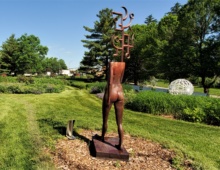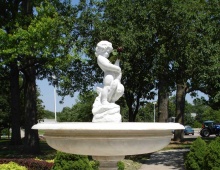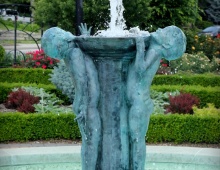

Edith Barretto Stevens, grandmother of Serena Pelissier, was born in Halifax, Virginia, in 1878, as her parents were residing there at the time. She died in New Canaan, Connecticut in 1956. When she was six years old the family moved from Virginia to New Jersey. She said that the move inspired her to become an artist: the Virginia property had been so beautiful, and she found the fiercely structured garden in New Jersey so ugly, that she decided to create work that celebrated the beauty of untouched nature. Her figures are pure in their natural state, with no added man-made ornamentation or sentimentality. In her best known figures of small children and animals, we can detect a connection, very subtly rendered, between the animals and the children: the Duck Baby’s hair, for example, flies out at the side, resembling little wings; the Baby Pan has tiny “horns” hidden in the curls on his forehead. There is that hint at connection to be found in each of them.
She studied from the age of 15 at the Art Students’ League in New York City, with, among others, Daniel Chester French, George L. Barnard and John Twachtman, and she worked as apprentice to James Earle Fraser. In 1903, at the age of 25, she was appointed to design the pediment of the main entrance to the Liberal Arts Building at the St. Louis fair. In 1908 she married Howard Parsons, one of the many direct descendants of Charles Willson Peale and the slightly fewer descendants of Rembrandt Peale. They had one child, their daughter Edith Gilman Parsons, who married Howard French.
Mrs. Parsons’ best-known works are the garden sculptures she made between 1911 and 1930: the Duck Baby (1911), the Turtle Baby (1915), the Frog Baby (1917), the Joy Fountain (1919), the Little Duck Fountain (1921), the Big Duck (1925), and the Baby Pan (1930). The original molds of some of these pieces survived in the possession of Mrs. Parsons’ daughter Edith French and her daughter Serena Pelissier, and a very limited number of authorized recasts have been available for sale.
She worked constantly in her studios (in New York City and Quogue, Long Island, New York) until illness kept her from it.
Quoting an anonymous newspaper article from the 1920s, “Though intensely reticent about herself one may, if privileged to enter that home, breathe there the spirit of the gifted woman who has been able to imprison in bronze the smile of a little child.”





